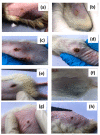Antidiabetic Wound Dressing Materials Based on Cellulosic Fabrics Loaded with Zinc Oxide Nanoparticles Synthesized by Solid-State Method
- PMID: 35683840
- PMCID: PMC9183095
- DOI: 10.3390/polym14112168
Antidiabetic Wound Dressing Materials Based on Cellulosic Fabrics Loaded with Zinc Oxide Nanoparticles Synthesized by Solid-State Method
Abstract
The current study aims for the use of the solid-state technique as an efficient way for the preparation of zinc oxide nanoparticles (ZnONPs) as an antimicrobial agent with high concentration using sodium alginate as stabilizing agent. ZnONPs were prepared with three different concentrations: ZnONPs-1, ZnONPs-2, and ZnONPs-3 (attributed to the utilized different concentrations of zinc acetate, 1.5, 3 and 4.5 g, respectively). The as-fabricated ZnONPs (ZnONPs-1, ZnONPs-2, and ZnONPs-3) were used for the treatment of cellulosic fabrics as dressing materials for the diabetic wounds. DLS findings illustrated that the as-prepared ZnONPs exhibited average particle size equal to 78, 117, and 144 nm, respectively. The data also showed that all the formulated ZnONPs were formed with good stability (above -30 mv). The topographical images of cellulosic fabrics loaded with ZnONPs that were obtained by SEM confirmed the deposition of nanoparticles onto the surface of cellulosic fabrics with no noticeable agglomeration. The findings also outlined that the treated cellulosic fabrics dressings were proven to have enhanced bactericidal characteristics against the pathogenic microorganisms. The finding of wound contraction for the diabetic rats was measured after 21 days and reached 93.5% after treating the diabetic wound with cotton fabrics containing ZnONPs-2. Ultimately, the generated wound dressing (cellulosic fabrics loaded with ZnONPs) offers considerable promise for treating the wound infections and might be examined as a viable alternative to antibiotics and topical wound treatments.
Keywords: antidiabetic; cellulosic fabrics; wound dressing; zinc oxide nanoparticles.
Conflict of interest statement
The authors declare no conflict of interest.
Figures










References
-
- Romano N., Zeng C. Toxic effects of ammonia, nitrite, and nitrate to decapod crustaceans: A review on factors influencing their toxicity, physiological consequences, and coping mechanisms. Rev. Fish. Sci. 2013;21:1–21. doi: 10.1080/10641262.2012.753404. - DOI
-
- Obaid M.N., Sabr O.H., Hussein A.A. Characteristic of polypropylene nanocomposite material reinforcement with hydroxyapatite for bone replacement. J. Achiev. Mater. Manuf. Eng. 2021;104 doi: 10.5604/01.3001.0014.8483. - DOI
-
- Hariharan D., Thangamuniyandi P., Christy A.J., Vasantharaja R., Selvakumar P., Sagadevan S., Pugazhendhi A., Nehru L.C. Enhanced photocatalysis and anticancer activity of green hydrothermal synthesized Ag@TiO2 nanoparticles. J. Photochem. Photobiol. B Biol. 2020;202:111636. doi: 10.1016/j.jphotobiol.2019.111636. - DOI - PubMed
LinkOut - more resources
Full Text Sources

